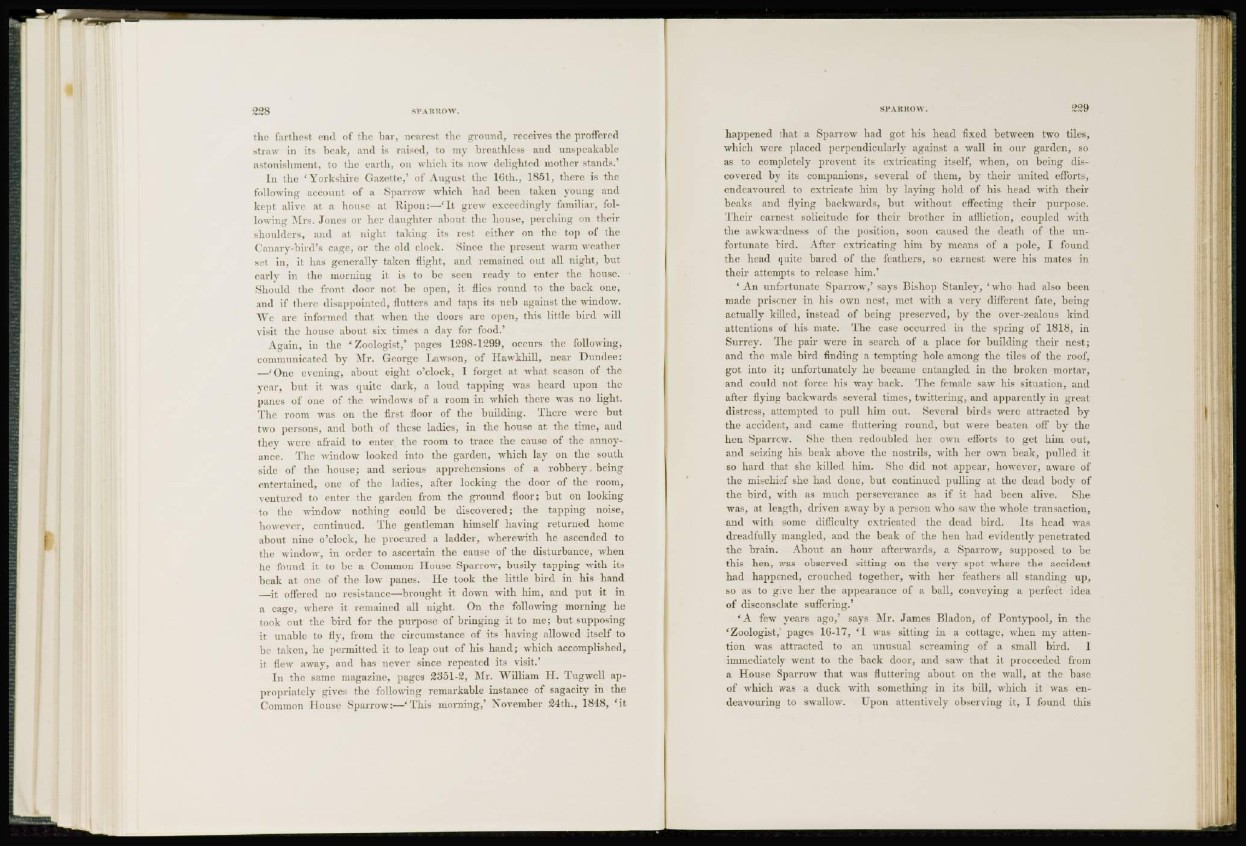
the farthest end of the bar, nearest the ground, receives the proffered
straw in its beak, and is raised, to my breathless and unspeakable
astonishment, to the earth, on which its now delighted mother stands.1
In the 'Yorkshire Gazette.' of August the 16th., 1851, there is the
following account of a Sparrow which had been taken young and
kept alive at a house at Ripon:—'It grew exceedingly familiar, following
.Mrs. Jones or her daughter about the house, perching on their
shoulders, and at night taking its rest either on the top of the
Canary-bird's cage, or the old clock. Since the present warm weather
set in, it has generally taken flight, and remained out all night, but
early in the morning it is to be seen ready to enter the house.
Should the front door not hi- open, it flies round to the back one,
and if there disappointed, flutters and taps its neb against the window.
We are informed that when the doors arc open, this little bird will
visit the house about six times a day for food.'
Again, in the 'Zoologist,' pages 1298-1299, occurs the following,
communicated by .Mr. George Lawson, of Hawkhill, near Dundee:
—'One evening, about eight o'clock, I forget at what season of the
year, but it was quite dark, a loud tapping was heard upon the
panes of one of the windows of a room in which there was no light.
The room was on the first floor of the building. There were but
two persons, and both of these ladies, in the house at the time, and
they were afraid to enter the room to trace the cause of the annoyance1.
The window looked into the garden, which lay on the south
side of the house; and serious apprehensions of a robbery being
entertained, one of the ladies, after locking the door of the room,
ventured to enter the garden from the ground floor; but on looking
to the window nothing could be discovered; the tapping noise,
however, continued. The gentleman himself having returned home
about nine o'clock, he procured a ladder, wherewith he ascended to
the window, in order to ascertain the cause of the disturbance, when
he found it to be a Common House Sparrow, busily tapping with its
beak at one of the low panes. He took the little bird in his hand
—it offered no resistance—brought it down with him, and put it in
a cage, where it remained all night. On the following morning he
took out the bird for the purpose of bringing it to me; but supposing
it unable to fly, from the circumstance of its having allowed itself to
be taken, he permitted it to leap out of his hand; which accomplished,
it flew away, and has never since repeated its visit.'
In the same magazine, pages 2351-2, Mr. William H. Tugwell appropriately
gives the following remarkable instance of sagacity in the
Common House Sparrow:—'This morning,* November 24th., 1848, 'it
happened that a Sparrow had got his head fixed between two tiles,
which were placed perpendicularly against a wall in our garden, so
as to completely prevent its extricating itself, when, on being discovered
by its companions, several of them, by their united efforts,
endeavoured to extricate him by laying hold of his head with their
beaks and flying backwards, but without effecting their purpose.
Their earnest solicitude for their brother in affliction, coupled with
the awkwardness of the position, soon caused the death of the unfortunate
bird. After extricating him by means of a pole, I found
the head quite bared of the feathers, so earnest were his mates in
their attempts to release him.1
'An unfortunate Sparrow,' says Bishop Stanley, 'who had also been
made prisoner in his own nest, met with a very different fate, being
actually killed, instead of being preserved, by the over-zealous kind
attentions of his mate. The case occurred in the spring of 1818, in
Surrey. The pair were in search of a place for building their nest;
and the male bird finding a tempting hole among the tiles of the roof,
got into it; unfortunately he became entangled in the broken mortar,
and could not force his way back. The female saw his situation, and
after flying backwards several times, twittering, and apparently in great
distress, attempted to pull him out. Several birds were attracted by
the accident, and came fluttering round, but were beaten off by the
hen Sparrow. She then redoubled her own efforts to get him out,
and seizing his beak above the nostrils, with her own beak, pulled it
so hard that she killed him. She did not appear, however, aware of
the mischief she had done, but continued pulling at the dead body of
the bird, with as much perseverance as if it had been alive. She
was, at length, driven away by a person who saw the whole transaction,
and with some difficulty extricated the dead bird. Its head was
dreadfully mangled, and the beak of the hen had evidently penetrated
the brain. About an hour afterwards, a Sparrow, supposed to be
this hen, was observed sitting on the very spot where the accident
had happened, crouched together, with her feathers all standing up,
so as to give her the appearance of a ball, conveying a perfect idea
of disconsolate suffering.'
' A few years ago/ says Mr. James Bladon, of Pontypool, in the
'Zoologist,' pages 16-17, ' I was sitting in a cottage, when my attention
was attracted to an unusual screaming of a small bird. I
immediately went to the back door, and saw that it proceeded from
a House Sparrow that was fluttering about on the wall, at the base
of which was a duck with something in its bill, which it was endeavouring
to swallow. Upon attentively observing it, I found this